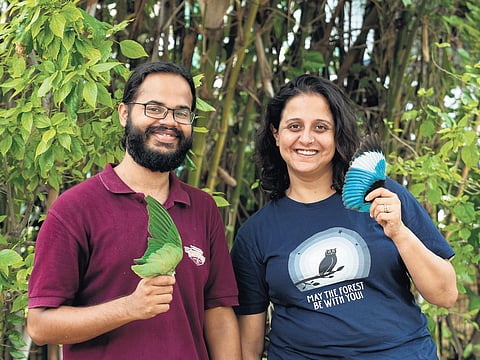

On a sunny afternoon during the lockdown, an Indian silverbill flew into Esha Munshi’s Ahmedabad home. Her pet cat attacked it. Munshi managed to rescue the bird, which, in fright, lost a few feathers. The plumage intrigued Munshi, an avid bird-watcher, driving her to the bounties of the internet, but in vain.
And the Feather Library, an online collection of bird plumage, was born. Documented in master plates, the exhibits carry information such as name of the subspecies, a unique ID, date it was recorded on, gender, location, reason for death and dimensions of the bird. Started in November 2021, Feather Library will be an important tool to identify species at the upcoming nationwide Campus Bird Count 2023, to be held between February 17 and 20, which will document birds from across campuses in India—educational and government institutions, research and corporate campuses, and more.
To build the collection, 35-year-old Munshi and co-founder-cum-bird rescuer Sherwin Everett, 30, who is also based in Ahmedabad, reached out to bird rescue centres in the city. What started with 10 species now has 110 documented ones with 250 specimens of feathers. “Even in similar-looking birds, there could be sexual dimorphism as far as feathers are concerned,” Munshi says.
The green bee-eater, for instance, has four feather specimens—two females, one male and one sub-adult male—while the Asian koel has five specimens, including one male, three female and one sub-adult female. Likewise, there are six specimens of the common myna—three male, two female and one juvenile.
Munshi is currently only documenting the flight feathers (feathers on the wings) and not body feathers. “For example, we have a bird called wallcreeper, which is grey and black, but when it opens its wings, you can see the red. The common myna is a brown bird, but its flight feathers are black and white. The hoopoe’s feathers have beautiful patterns on the wings that are normally invisible, unless in flight,” she says.
Munshi hopes to add more value to her venture by taking X-Rays (for skeleton details) and CT scans (for soft tissue details). While she currently has permission to work on bird feathers only in Gujarat, she wants to get the Forest Department of Karnataka on board to start working on birds of the state. “I want to create a network of rescue centres because I feel they have a huge scientific database, which is not being used,” she says.